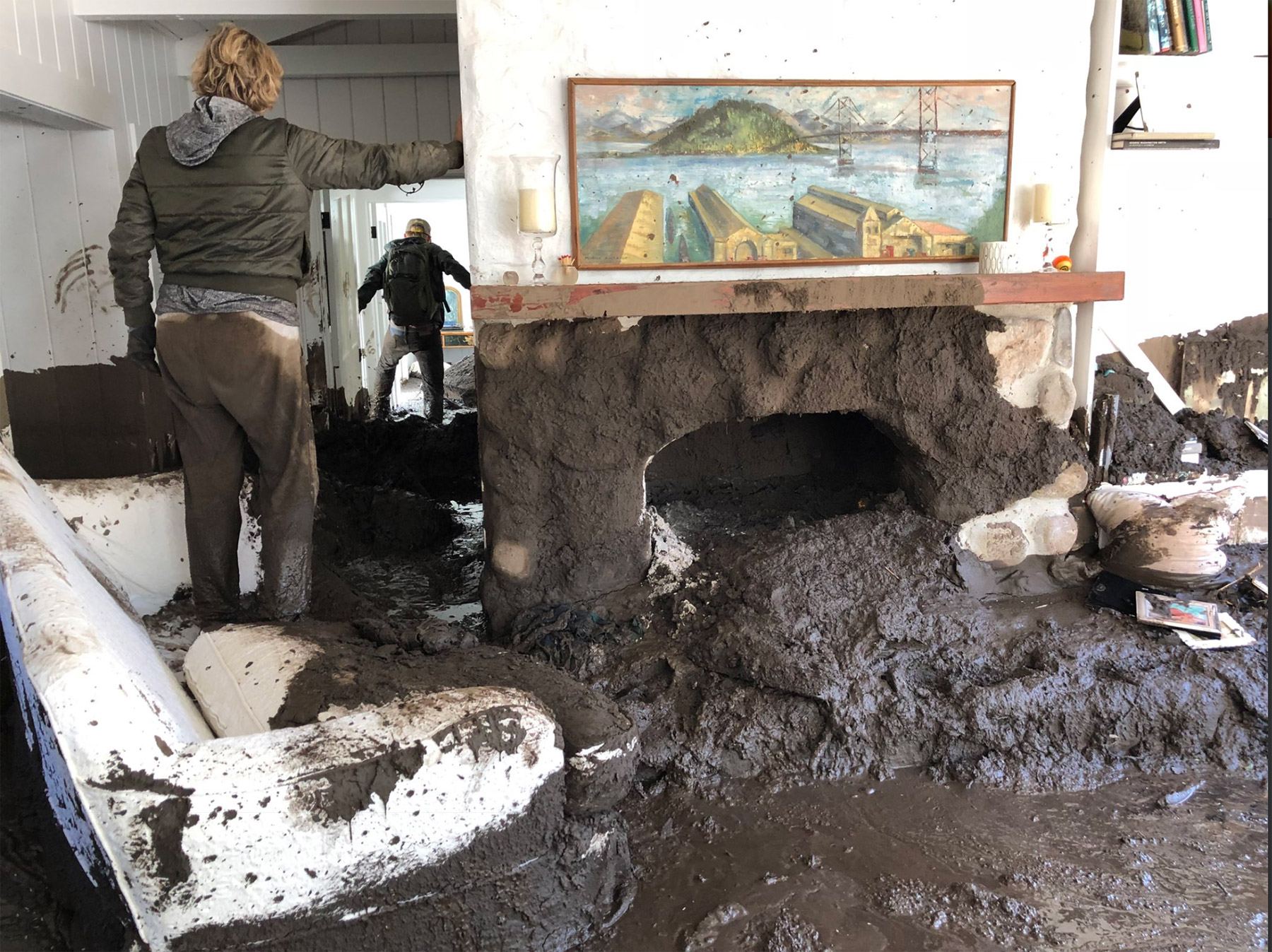Stories of Heroism, Heartbreak Emerge from Montecito Mudslides
17 People Killed and 100 Homes Destroyed in Post-Thomas Fire Disaster
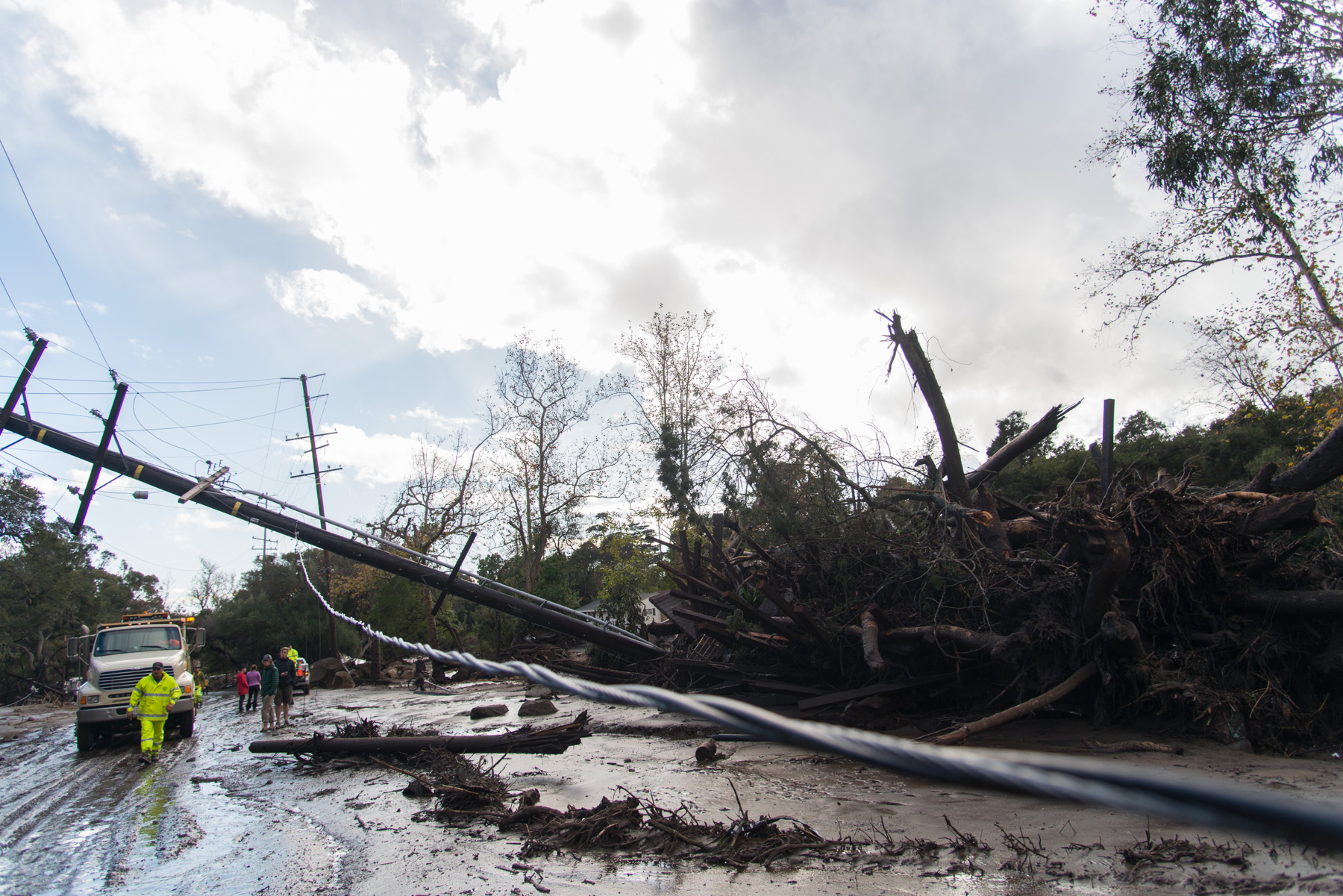
Mere weeks after the largest wildfire in state history scorched the foothills of Montecito, disaster struck yet again Tuesday morning as devastating mudslides triggered by heavy rainfall reduced much of the coastal community to what officials described as a scene resembling a World War I battlefield.
Fallen trees, massive boulders, and household debris littered streets lined with mangled cars and several dozen shattered homes, some sheared completely from their foundations. Among the wreckage were the bodies of victims swept away by flooding, concentrated most heavily between Cold Spring and Romero canyons. The liquefied mud had raced downslope and blasted through creek beds all the way to Highway 101.
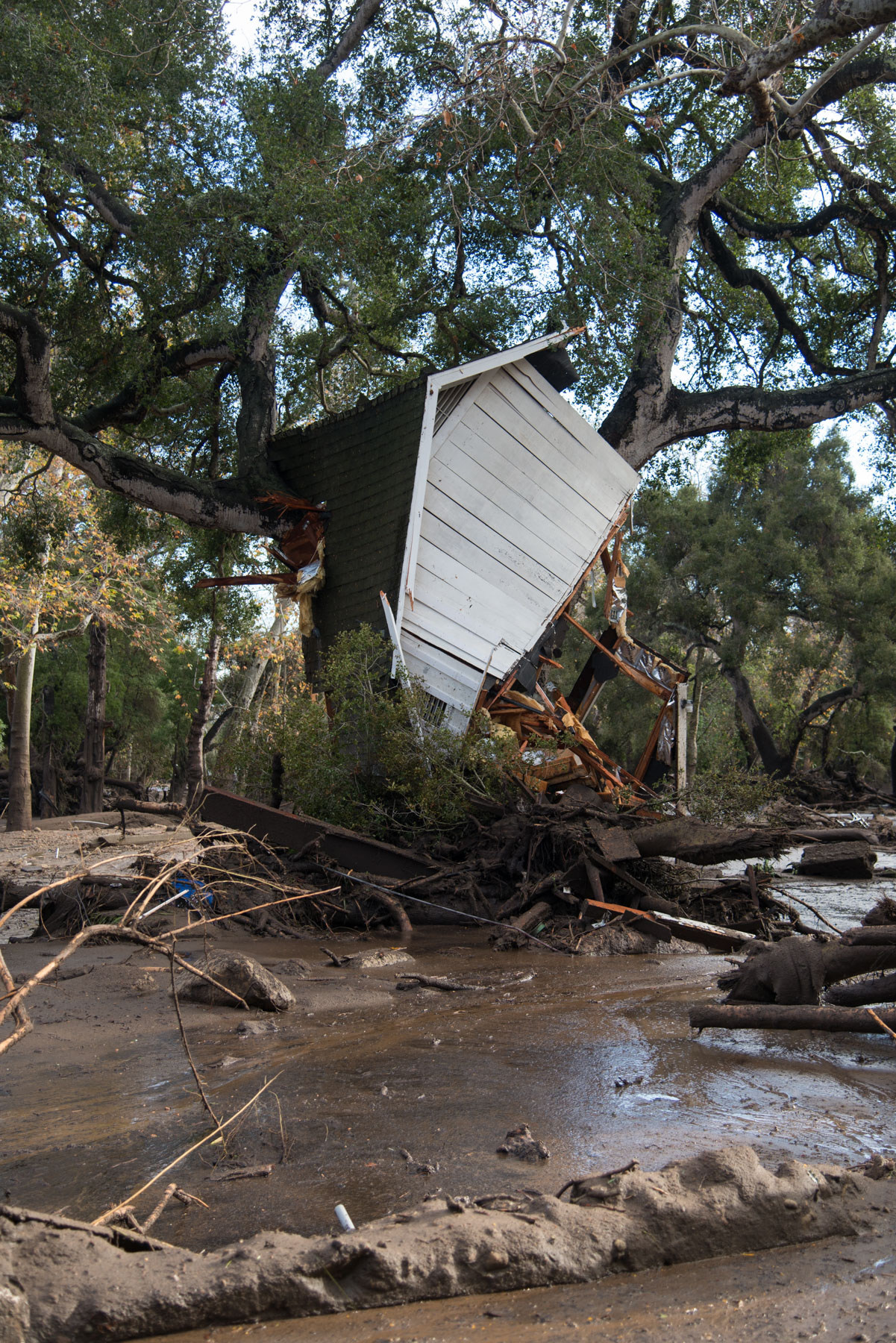
As of Wednesday evening, incident commanders reported 17 fatalities, 28 injured, 16 missing, and 100 sheltering in place. The death toll is expected to rise in the coming days as rescue attempts give way to recovery efforts. One thousand people had evacuated. More than 300 people were still trapped Wednesday behind impassable roads in Romero Canyon, where air rescues were actively underway. Many areas remain inaccessible, but 100 single-family residences have been reported destroyed and another 300 damaged. Eight nonresidential properties were also destroyed and another 20 damaged.
Video footage of a Coast Guard helicopter in the area showed a couple, their three children, and their two dogs being hoisted to safety. Nearby, after search and rescue personnel pinpointed muffled cries for help, firefighters spent two hours sawing through a collapsed house to reach a 14-year-old girl trapped inside. A 23-year-old man dragged half a mile south from his Hot Springs Road home was miraculously rescued under a 101 overpass. He sustained moderate injuries and is expected to survive. His 64-year-old father, however, remains missing.
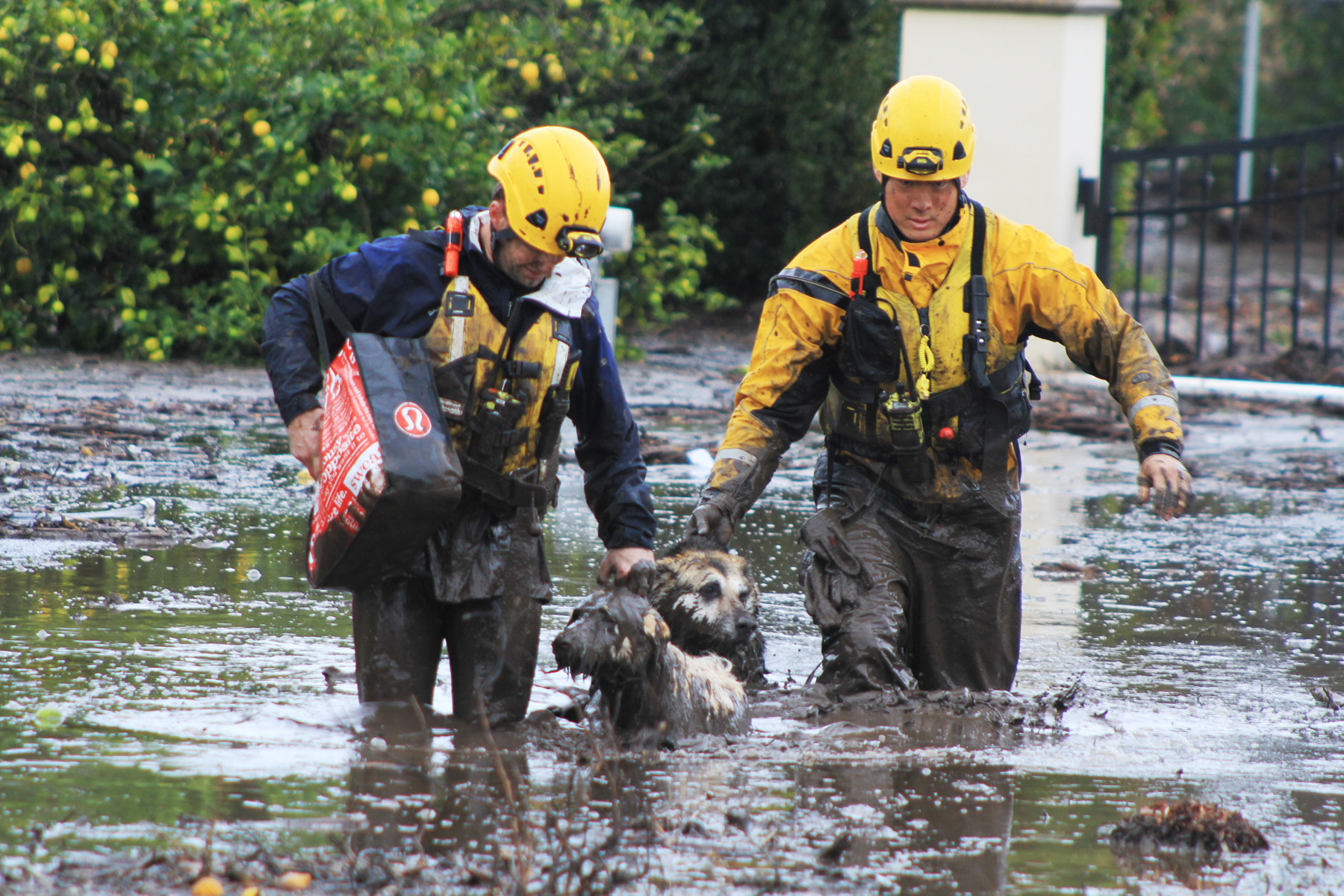
Sheriff Bill Brown said Tuesday that the identities of the deceased victims were not being released until their families had been notified. Ventura County officials did confirm that Roy Rohter, founder of the St. Augustine Academy, was among those killed. His wife, Theresa, was rescued and is in stable condition. Michael F. McLean, president of Thomas Aquinas College, which Rohter’s daughter attended, issued a statement on the school’s website: “Roy Rohter was a man of strong faith and a great friend of Catholic education. He played a pivotal role in the lives of countless young Catholic students — students who came to a deeper knowledge and love of Christ because of his vision, commitment and generosity.”
At Santa Barbara’s City Council meeting on Tuesday, City Fire Chief Pat McElroy, scheduled to retire next week, made perhaps the toughest presentation he’s ever had to make. It was supposed to be an update on the Thomas Fire, effectively extinguished now, but McElroy had grim news to deliver. Bodies were being exhumed from the muck. More were certainly to come. Normally a man of infectious optimism, McElroy struggled to maintain his composure. He lost it at the number of the dead.
The mudslides, McElroy said, are clearly part of the Thomas Fire, which has now pushed past 280,000 acres, but state and federal rules and regulations may or may not see them as separate disasters. At stake in the answer could be many millions of dollars.
McElroy sought to put the day’s events into context. “To some who call Santa Barbara home,” he said, “this is a real tragedy.”
Though the scope of Tuesday’s tragedy remains difficult to fathom, the weather conditions that triggered it were not unexpected. Last Friday, January 5, forecasters announced that the first big storm of the season was set to arrive Monday night, dropping as much as two inches along the coast and twice that in the mountains. Flooding was expected, they said, especially in and below the Thomas Fire burn scar between Montecito and Carpinteria.
“We need to organize and inform the public about [this] very clear and present danger,” said 1st District Supervisor Das Williams at a press conference outside Carpinteria City Hall. Officials on hand, including Office of Emergency Management Director Robert Lewin and County Public Works Deputy Director Tom Fayram, warned that the potential for flash floods in the burn area this season was 10 times greater than a normal year because the Thomas has burned off the top layer of soil that normally acts as a sponge during rainstorms.
Lewin said the fire denuded and destabilized 17 major canyons across Montecito and Carpinteria. He identified “four critical areas” that were dangerously vulnerable to flash floods and attendant mud and debris: within the burn scar, immediately outside its perimeter, creek-side properties, and lowlands with histories of flooding. Lewin encouraged residents to visit an interactive map on the county’s website that pinpointed homes in dangerous areas. He also strongly suggested residents sign up for the county’s emergency warning system, awareandprepare.org.
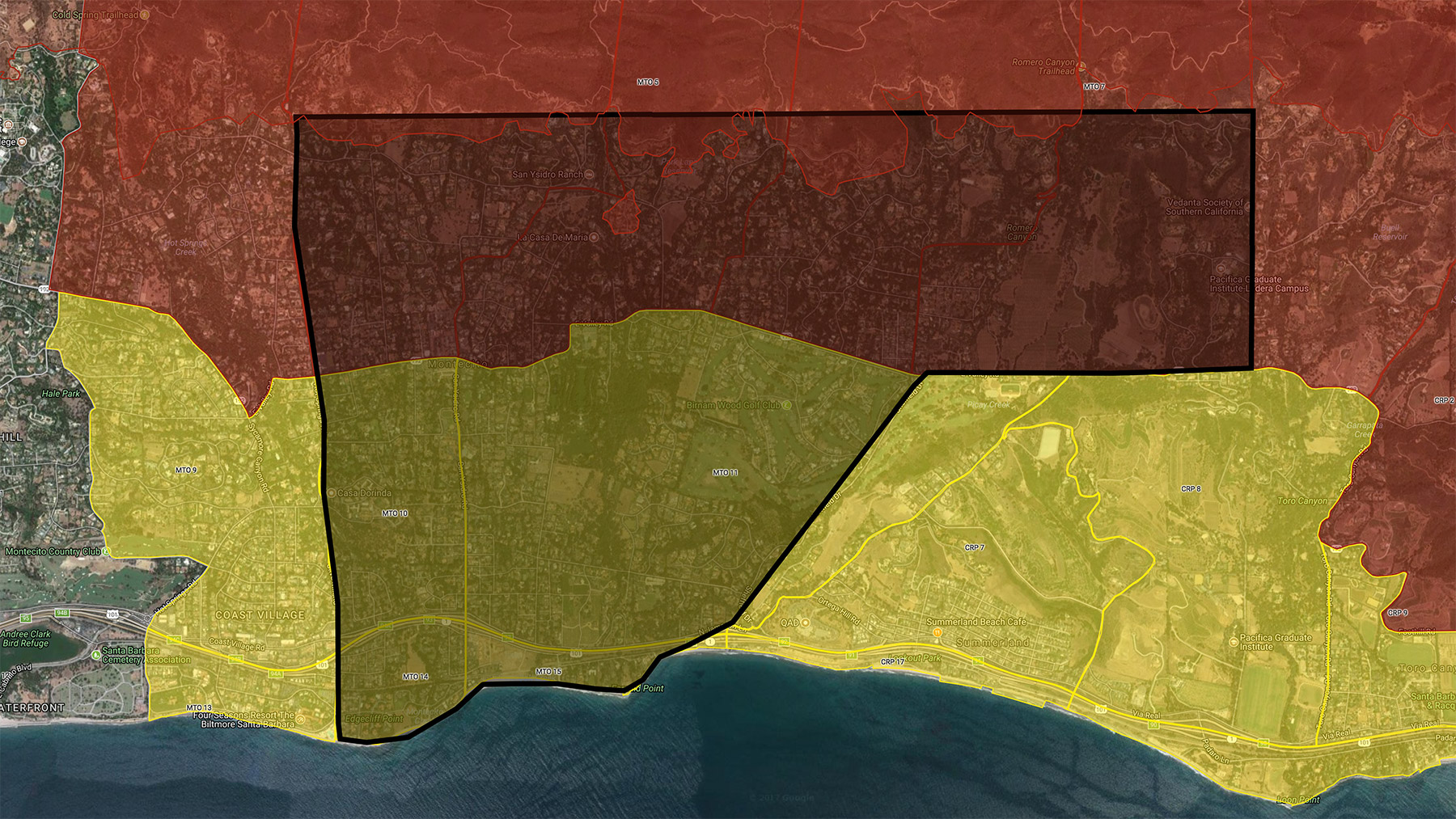
By Sunday, January 7, meteorologists had revised and increased their rainfall predictions, and parts of Santa Barbara County were put under a mandatory evacuation order at noon on Monday. The evacuation zone map closely mirrored the one created during the Thomas Fire — this week’s mandatory order extended above (north of) Highway 192/Foothill Road, from the county line to Cold Springs Road; the voluntary evacuation warning extended south of 192 from the county line to Hot Springs/Olive Mill roads. Residents living in areas heavily impacted by the Whittier, Sherpa, and Rey fires were also told to leave. A county-sponsored storm update meeting scheduled for Monday was canceled to keep people off the roads.
Despite these warnings, many Montecito residents refused to leave their homes. Sheriff Brown said his deputies spent Monday going door-to-door to issue the mandatory evacuation order in zones where approximately 7,000 people live. “While some residents cooperated, many did not and chose to stay in place,” he said. Brown emphasized he was “heartbroken” by the loss of life but noted that “the efforts [Monday] night and [Tuesday] resulted in many lives that were saved.”
Brown speculated that those residents who stayed behind did so out of frustration and fatigue after they’d been forced to evacuate during the Thomas Fire. They may also simply have hoped for the best and refused to accept the extent of the danger. “I think they thought this was not going to be a problem, when obviously it was,” he said.
Martin Tait, a 65-year-old retired homebuilder who lives on Crespi Lane, was among the holdouts. “After two and a half weeks of being evacuated by the fire, we decided to hang tight and see what happened,” he said. “We got lucky.”
Brown struck a somber yet slightly defensive tone when asked about the deaths and damage that occurred within voluntary evacuation zones. Both mandatory orders and voluntary warnings were issued based on information and predictions compiled by meteorologists, Cal Fire and Forest Service personnel, and flood district staff, he said. “This isn’t an exact science in terms of defining where [a mudslide] is going to happen,” he explained. “A lot depends on Mother Nature. This was their best-guess estimate of where things were going to occur, and as it turns out, they were exactly right.” Brown said it was impossible to predict to “a house or a block or a neighborhood what the impact was going to be.”
Pushed by a strong cold front, Tuesday’s storm delivered “unprecedented” amounts of rain to the foothills, at one point dropping 0.54 inches in just five minutes. Meteorologists said the threshold for flash flood warnings is a rain event that delivers 0.20 inches in 15 minutes.
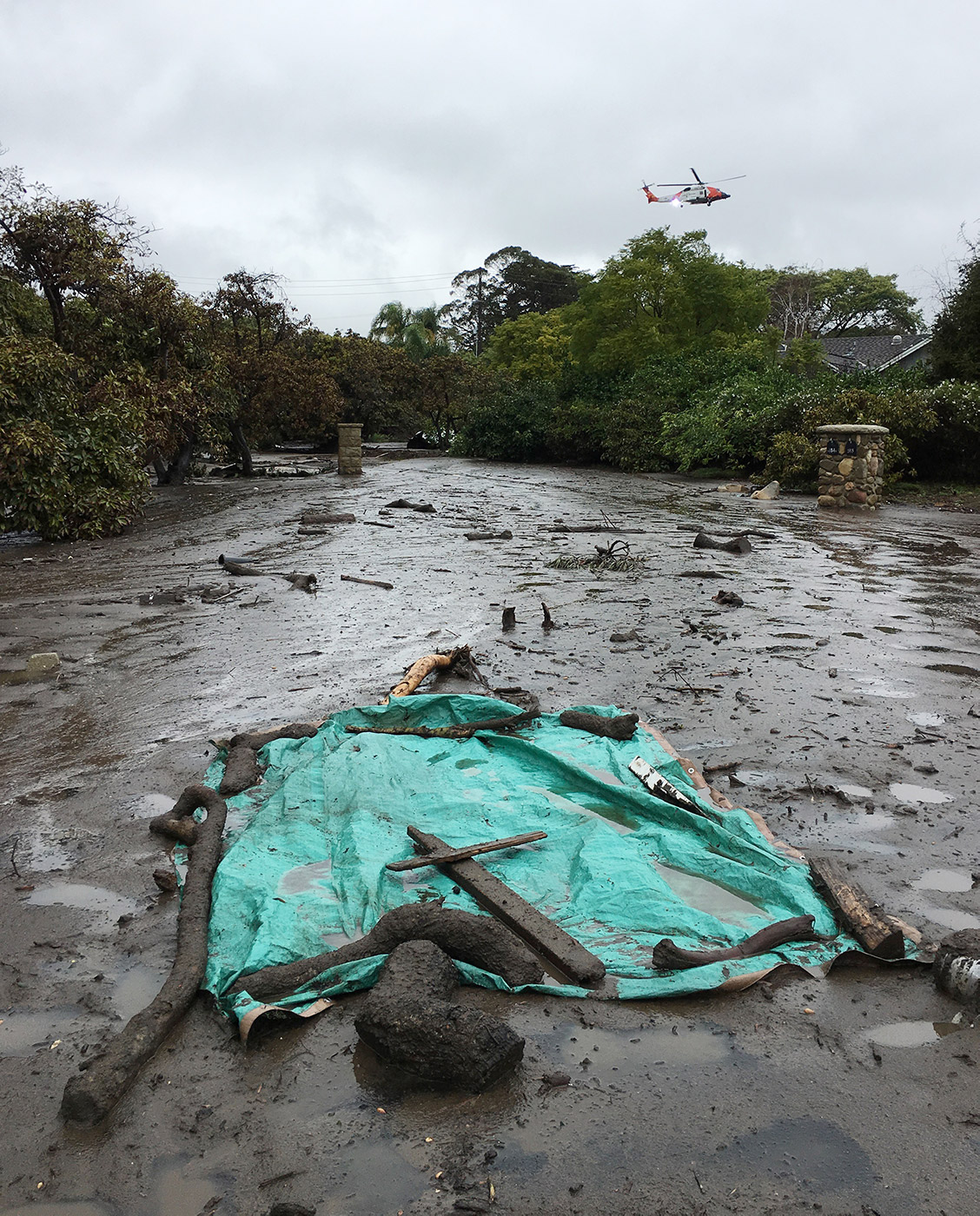
Such was the power of the resulting mudflow that when former Independent photographer Kim Reierson found a woman at the foot of her driveway, all the woman’s clothing and jewelry had been stripped away by the storm, as had one of her arms. Reierson called the authorities about the woman, who was in her fifties or sixties, and a responding helicopter rescue crew ascertained from on high that the woman was dead. They left the body with Reierson, who covered it up with a green tarp when the crows started circling and placed a cross on top.
Emergency 9-1-1 dispatchers on Tuesday received over 600 calls between 3 and 6 a.m. from hurt and trapped Montecito residents, Brown said. The 458 firefighters and rescue personnel who’ve descended on the scene remain hampered by extreme conditions and difficult obstacles, including fields of mud with a consistency close to wet concrete that make basic movements difficult, he said.
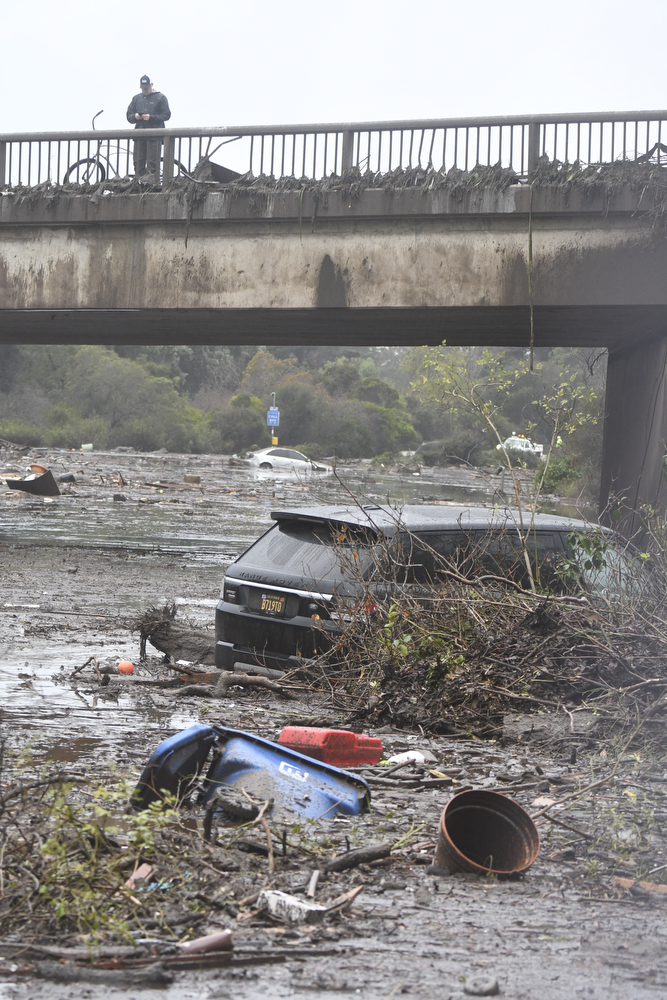
Public Works’ Fayram said crews had worked “feverishly” over the last several weeks to clear debris basins in the wake of the Thomas Fire and in anticipation of mudslides. His department and Cal Fire strike teams “did absolutely everything we could do in advance of the storm,” he said, and worked right up until Monday night before the rains arrived. Intensive clearing efforts will take place in the coming days and weeks to restore drainage back into creeks and channels ahead of upcoming storms, Fayram said.
Highway 101 remains closed between Seacliff to the south and the Milpas Street exit to the north, as of Wednesday morning. Caltrans expects the closure to last until Monday. It has dispatched five front-loading dozers and more than 20 container trucks from San Luis Obispo to clear the way. Earlier efforts were slowed by a broken water main along Olive Mill Road that flooded the freeway already covered by sludge and debris.
Authorities have issued boil-water notices for all Montecito Water District customers, as the rainstorm and debris flows severely damaged the South Coast Conduit, the 26-mile pipeline that carries water from the northern part of Lake Cachuma to Montecito and Carpinteria. Its exact condition is still unclear, Supervisor Williams said, but the preliminary reports are “very bad.” It appears to have ruptured at points along a three- to four-mile stretch from Barker Pass to Ortega Reservoir.
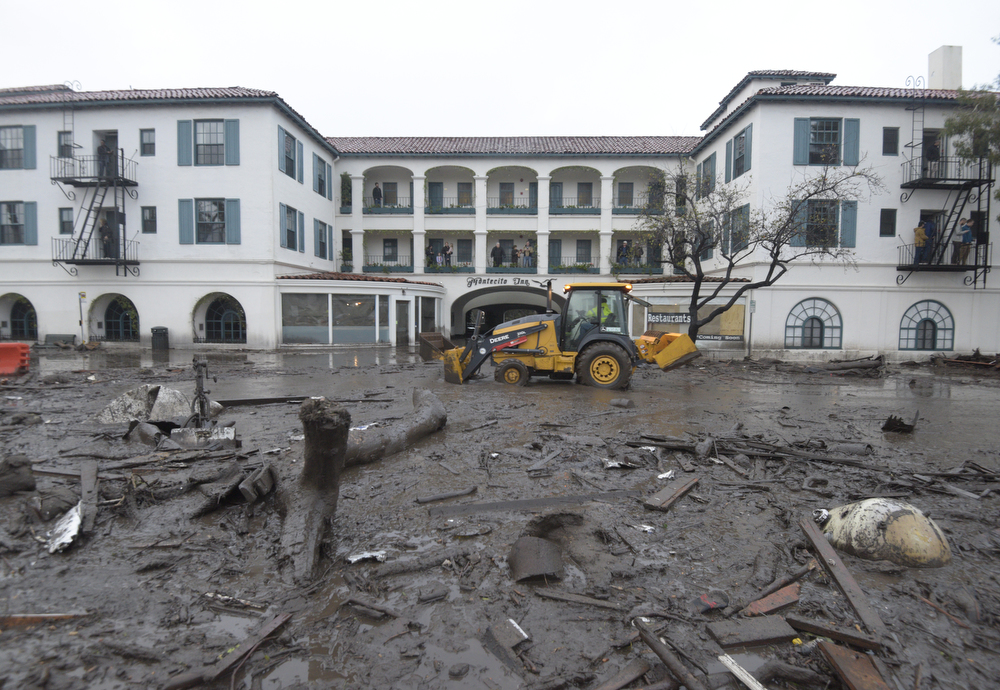
Parts of the district are currently without water altogether. Other areas will soon lose service as well, according to Montecito Water District Manager Nick Turner. Turner could not say the total number of customers impacted. “We will be working 24 hours a day to finish identifying the main break locations and getting them repaired,” Turner said. “It is going to take days.”
The pipeline is the main source of water for the South Coast. According to the Cachuma Operation and Maintenance Board, “No redundant pipeline exists for conveyance of water supply in the South Coast Conduit when a section of the pipeline needs to be isolated for emergencies or repair.” Montecito Water District staff advised customers to bring all water to a boil for one minute and then let it cool before using. “Boiled or bottled water should be used for drinking and food preparation until further notice. This is the preferred method to assure that the water is safe to drink,” district staff said in a statement.
Westmont College did not sustain significant flooding in the storm, but due to the compromised water service, canceled classes through Friday. San Ysidro Ranch, barely saved during the Thomas Fire and scheduled to reopen this week, is reported to have sustained heavy damage.
The All Saints-by-the-Sea Episcopal Church in Montecito at 83 Eucalyptus Lane is continuing to operate as a temporary triage center for injured and evacuated residents. People began arriving at the church around 4 a.m. Tuesday. “My wife, Alyson, started opening up the parish hall and lighting candles,” said Pastor Aimée Eyer-Delevett. “And I sent a text throughout the neighborhood for blankets and other things we needed. People showing up drenched, covered in mud and traumatized, separated from family members.”
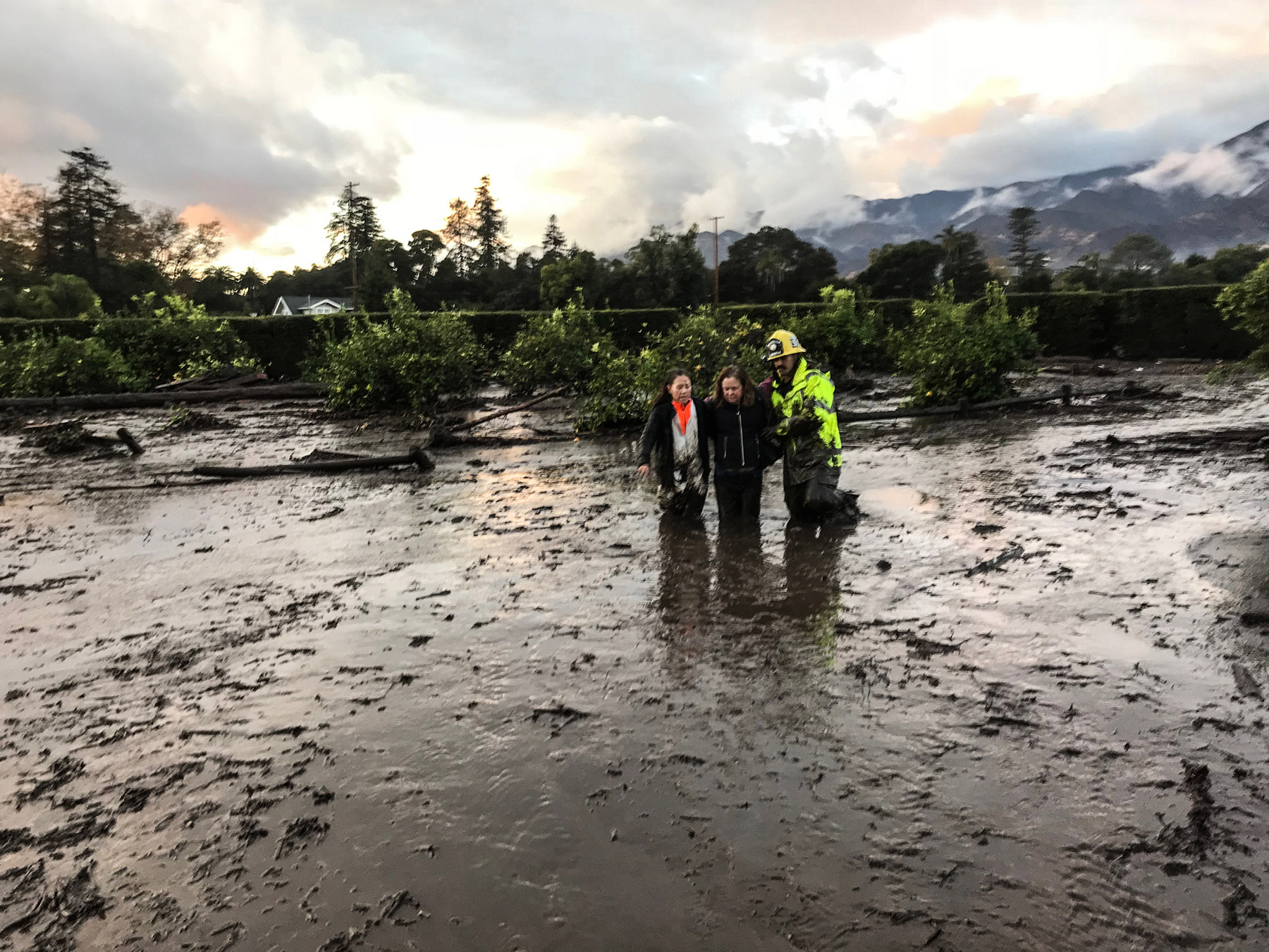
Approximately 10 people with nonserious injuries were treated before being transported by four-wheel-drive U.S. Army vehicles through clogged roads to the Vons grocery store on Coast Village Road. From there, they were taken to Cottage Hospital and then reunited with family at Santa Barbara City College, where a Red Cross shelter has been erected. Those seriously injured are being medevaced from the athletic field at Montecito Union School.
Cottage Hospital activated its Incident Command Center shortly after 5:30 a.m., when the first of the mudslide victims began arriving by medevac. Fortunately, the timing coincided with a scheduled shift change, so the emergency room was essentially double-staffed with doctors and nurses for the remainder of the morning and afternoon. By 3 p.m., 20 patients had arrived, four in serious condition. A number of medical staff who live in Ventura were unable to commute north, however; 13 percent of Cottage’s employees live there. The Condor Express and Island Packers have offered to ferry workers up the coast by boat.
A Family Assistance Center meant for those directly impacted by the mudslides is operating out of the First Presbyterian Church in Santa Barbara at 21 East Constance Avenue. Victims and their friends and family in need of psychological or spiritual support are welcome, said a County Behavioral Wellness spokesperson, who asked the public and members of the media to respect their privacy. The Center will be open from 8 a.m. to 8 p.m. and can be reached by phone at 364-1822.
Santa Barbara City College is hosting a Red Cross shelter in its gymnasium, where hot meals and warm clothing are being distributed. The most effective way for the public to offer its help, a spokesperson said, is to make a financial donation through the Red Cross website so the aid organization “can purchase exactly what our clients will need.” Those wishing to volunteer can also sign up online.
Santa Barbara hotels have stepped up and are offering special rates to flood victims and evacuees. The list can be found at sbchamber.org.
